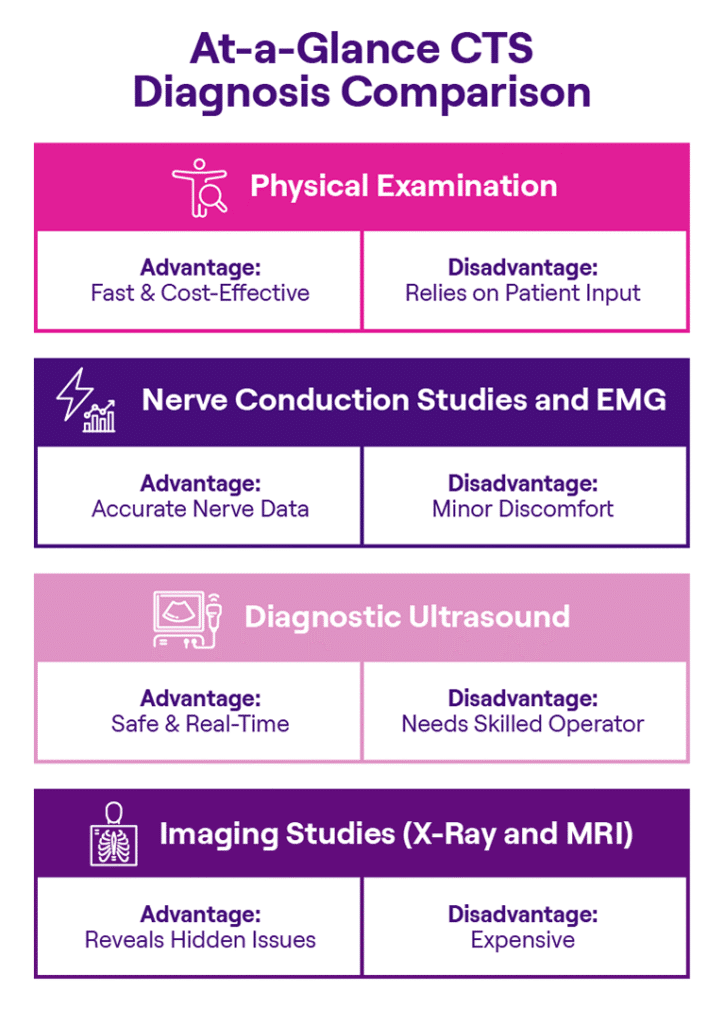Carpal tunnel syndrome (CTS) is a common condition that affects the hand and wrist, causing tingling, numbness, and pain. It occurs when the median nerve, which runs from the forearm into the hand, becomes compressed as it passes through the carpal tunnel in the wrist. If left untreated, CTS can interfere with daily activities and cause long-term complications. That’s why receiving an accurate diagnosis is crucial to managing this condition effectively.
This guide provides an overview of CTS, its symptoms, risk factors, and the importance of early and accurate diagnosis. You’ll also learn about common diagnostic methods used to confirm CTS and tips to help you prepare for your evaluation. Whether you’re experiencing wrist-related concerns or seeking more information about CTS, this guide will help you understand the diagnostic process and its significance in developing targeted treatment plans.
Understanding Carpal Tunnel Syndrome (CTS)
Carpal tunnel syndrome (CTS) occurs when the median nerve, a critical nerve running from your forearm into your hand, becomes compressed as it passes through the carpal tunnel in the wrist. This narrow passageway not only houses the median nerve but also the tendons responsible for finger and hand movement. Over time, repetitive hand or wrist movements, pregnancy, or underlying medical conditions can increase pressure on the median nerve, causing it to become swollen and inflamed.
Recognizing the Key Symptoms
CTS symptoms often start gradually and can worsen over time. Common signs include:
- Tingling or pins-and-needles sensation in the thumb, index, and middle fingers.
- Numbness, often noticeable at night or during certain repetitive movements.
- Mild to burning pain in the wrist, sometimes radiating up the forearm.
- Reduced grip strength or frequent dropping of objects.
These signs may manifest in one or both hands, with most individuals reporting a greater impact on their dominant hand. In advanced stages, symptoms may include weakened grip strength or muscle atrophy in the hand’s base. However, some people experience no discomfort at all, despite clear signs of nerve compression.
How CTS Impacts Everyday Life
When left undiagnosed or untreated, CTS can interfere with even the simplest tasks. You might find it harder to type on a keyboard, grip objects securely, or perform hand-intensive activities like cooking or crafting. In some cases, the pain and numbness worsen enough to disrupt sleep or radiate toward the shoulder. Over time, persistent nerve compression may lead to muscle weakness or nerve changes requiring more attentive treatment.
Common Causes and Risk Factors
CTS is usually the result of a combination of factors that place increased pressure on the median nerve. These may include:
- Repetitive wrist and hand movements (prolonged typing, assembly-line work).
- Pregnancy-related fluid retention.
- Underlying conditions such as diabetes, rheumatoid arthritis, or thyroid disorders.
- Anatomical or genetic predispositions.
- Workplace habits with poor ergonomics.
The above factors may increase your risk of developing CTS. However, some people with no known risk factors may also develop this condition.
Take A Symptom Survey
Why an Accurate Diagnosis for CTS Matters
Accurately diagnosing this condition is a critical step in ensuring that you receive care tailored to your specific symptoms. Multiple hand and wrist problems may share overlapping signs with CTS, making a precise evaluation essential to avoid unnecessary or ineffective treatments.
Reducing Delays and Preventing Complications
Identifying carpal tunnel syndrome (CTS) early may help limit the progression of symptoms and reduce the risk of long-term complications. When left unaddressed, the median nerve might remain compressed, potentially leading to more severe tingling, numbness, or pain. In advanced cases, prolonged nerve compression may result in muscle weakness or permanent nerve changes. Early and accurate diagnosis allows healthcare providers to recommend adjustments or interventions that can help protect the nerve.
Tailoring the Right Treatment Plan
Each case of CTS is unique. Some individuals experience mild, occasional discomfort, while others deal with persistent symptoms that disrupt daily life. Accurate diagnosis helps providers determine the severity and underlying causes of your CTS, guiding decisions about the most suitable treatments. For instance, mild cases may respond to wrist splints or activity modifications, whereas more pronounced symptoms might call for further measures.
Alleviating Uncertainty
Living with unexplained tingling, pain, or numbness can be stressful. A confirmed diagnosis of CTS provides clarity, empowering you to take control of your symptoms. Knowing the root cause allows you to implement preventative measures, make lifestyle changes, and pursue targeted remedies. Even if you don’t have CTS, an accurate diagnosis can help identify other potential sources of discomfort, leading to alternative treatment or lifestyle adjustments.
Common Diagnostic Methods for CTS
Diagnosing CTS typically begins with a detailed review of your medical history and a physical examination. Below are a few testing methods that help confirm CTS and rule out other causes.
Physical Examination
The initial step often involves a thorough inspection of the wrist and hand. Healthcare providers look for swelling, tenderness, grip strength, and range of motion. Several specific tests are commonly performed:
- Tinel’s Test: Tapping along the median nerve near the wrist to see if it triggers tingling.
- Phalen’s Test: Flexing the wrists together to check if numbness arises within a minute.
- Durkan’s Test: Applying pressure over the carpal tunnel to provoke familiar tingling or numbness.
Though these tests are quick and cost-effective, they may not always conclusively detect CTS. Other causes like arthritis, tendonitis, or nerve problems elsewhere in the arm might produce similar symptoms.
Nerve Conduction Studies and Electromyography (EMG)
Nerve conduction studies involve placing small electrodes on the skin to measure signal speed through the median nerve. A noticeable slowdown in conduction may point to nerve compression. EMG goes deeper by inserting a fine needle electrode into the muscle to detect possible changes from prolonged nerve compression.
Although these methods can deliver detailed information, they may cause mild discomfort and require specialized appointments.
Imaging Studies
- X-rays can identify other causes, such as arthritis or fractures.
- MRI can reveal soft-tissue abnormalities, including tendon inflammation or cysts.
These modalities are typically reserved for complex scenarios when other tests do not clarify the diagnosis.
The Role of Diagnostic Ultrasound in CTS Evaluation

Diagnostic ultrasound has become a key tool in evaluating possible median nerve compression. As a non-invasive, patient-friendly method, it employs high-frequency sound waves to deliver real-time images of the median nerve and the carpal tunnel region.1 Its ability to offer immediate visual feedback helps healthcare providers identify nerve swelling or any structural changes without needles or radiation.1
How Diagnostic Ultrasound Works
A clinician glides a handheld ultrasound probe over the wrist with the help of a water-based gel. The sound waves reflect off internal structures and produce images on a screen instantaneously. Unlike static imaging tests, ultrasound allows dynamic views—capturing the median nerve’s movement and interactions with tendons or other tissues in different wrist positions.
Key Benefits of Diagnostic Ultrasound1
Completely painless, involving no needles or electrical impulses.
- Real-time imaging that shows the median nerve under varying wrist positions.
- Radiation-free.
- Cost-effective compared to higher-priced imaging like MRI.
Accuracy and Reliability
By measuring the median nerve’s cross-sectional area, ultrasound may reveal thickening or compression. This immediate imaging is often combined with other diagnostic tools to confirm findings. A recent study found ultrasound to have similar accuracy to nerve conduction studies, suggesting that either could be used for diagnosing CTS.
Combining Carpal Tunnel Release with Ultrasound Guidance
In addition to diagnostic ultrasound, providers sometimes use ultrasound guidance to assist with treatment. This technique, carpal tunnel release with ultrasound guidance (CTR-US)*, falls under the category of minimally invasive procedures and involves using ultrasound imaging to guide the release of the transverse carpal ligament, reducing the median nerve’s pressure. This approach may allow for a quicker recovery compared to traditional carpal tunnel release methods.2-5
*See below for link to important safety information.
What to Expect During a Diagnosis for CTS
Understanding the typical steps involved in diagnosing carpal tunnel syndrome can help you feel more prepared for your evaluation. While the exact path may vary based on your specific situation, here’s a general overview of what the process often looks like:
Initial Consultation: Sharing Your Story
Your visit will typically begin with a conversation. Your healthcare provider will want to hear about your symptoms in detail – what they feel like, when they started, what makes them better or worse, and how they impact your daily life. Be ready to share information about your job, hobbies, medical history, and any previous injuries, as this context is crucial.
Physical Examination: Hands-On Assessment
Next, expect a physical assessment of your hands, wrists, arms, and possibly your neck. Your provider will check for tenderness, swelling, muscle strength, and sensation. They will likely perform specific clinical tests, such as Tinel’s Test, Phalen’s Test, and Durkan’s Test (wrist compression), which are described in the ‘Common Diagnostic Methods for CTS’ section above. These maneuvers help determine if pressure on the median nerve pathway reproduces your symptoms.
Visualizing the Nerve: The Role of Diagnostic Ultrasound
Depending on the initial findings or your provider’s preference, diagnostic ultrasound might be used during the same visit or scheduled separately. As detailed previously, this painless, non-invasive method uses sound waves to create real-time images of your carpal tunnel. It allows your provider to visually assess the median nerve for signs of swelling or compression and examine surrounding structures.
Other Objective Nerve Testing: NCS and EMG
To get a more precise measure of nerve function, especially if the diagnosis is uncertain or to gauge severity, Nerve Conduction Studies (NCS) and Electromyography (EMG) may be recommended. Referring back to the ‘Common Diagnostic Methods’ section for how these tests work, they objectively measure how well your median nerve is transmitting signals and how your muscles are responding. Be aware these tests can involve mild, temporary discomfort and might require a separate appointment at a specialized facility.
Considering Other Possibilities: Imaging Studies
In situations where your symptoms might stem from other causes, or if the initial tests aren’t conclusive, your provider might order imaging studies like X-rays or MRI. As noted earlier, these aren’t routine for CTS diagnosis but are valuable for ruling out conditions like arthritis, fractures, or other structural issues that could be causing your symptoms.
Putting It All Together
The diagnostic process for CTS often involves combining information from your history, the physical exam, and potentially one or more of the specialized tests described above. Each step provides a piece of the puzzle, helping your healthcare provider arrive at an accurate diagnosis and determine the most appropriate next steps for your care.
Comparing Diagnostic Methods for CTS


No single test suits every scenario, and providers often combine different approaches to obtain a complete picture of carpal tunnel syndrome. Here’s a quick overview:
Physical Examination
- Advantages: Quick, inexpensive, and offers immediate feedback on possible nerve involvement.
- Disadvantages: Can be subjective based on patient reporting.
Nerve Conduction Studies and EMG
- Advantages: Quantitative, established measures of nerve function.
- Disadvantages: Mild discomfort and potentially higher cost or scheduling demands.
Diagnostic Ultrasound
- Advantages: Non-invasive, painless, real-time imaging with no radiation exposure.1
- Disadvantages: Operator-dependent; specialized expertise improves accuracy.
Imaging Studies (X-Ray and MRI)
- Advantages: Helpful in identifying or excluding structural abnormalities like fractures or tumors.
- Disadvantages: Higher costs and not routinely required for straightforward CTS cases.
Tips for Patients Considering CTS Diagnosis
Being proactive about a CTS evaluation may ease worries and boost the efficiency of any tests you undergo. Here are several steps you can take:
1. Keep a Record of Symptoms
Track how often symptoms arise, how severe they feel, and what triggers or relieves them. Consider including notes on the time of day, work tasks, or hobbies. If your concerns frequently flare up during computer-related tasks, explore effective ergonomic adjustments from credible sources for practical tips.
2. Explore Non-Invasive Testing Options
If you’d prefer to avoid needles, talk to your provider about diagnostic ultrasound. This gentle method lets you see real-time images of the median nerve, so you can ask immediate questions about any irregularities.1
3. Share Information About Your Lifestyle
Describe your work setting, hobbies, and general routines. If you have a repetitive job or a history of underlying conditions, these details may help your provider tailor a testing approach.
4. Ask Questions About Recommended Tests
Whether it’s nerve conduction studies, EMG, or ultrasound, don’t hesitate to find out about the level of comfort, approximate time commitment, and next steps for interpreting results.
5. Clarify Next Steps After Diagnosis
Should your results confirm CTS, discuss suitable treatments. Mild cases might respond well to splints, while more persistent symptoms could need a different course of action.
6. Consider Advanced Solutions if Needed
Your provider may propose traditional carpal tunnel release or carpal tunnel release with ultrasound guidance. CTR-US, a minimally invasive technique that may be performed in an office-based setting4,6 and may allow for a quicker recovery compared to traditional methods.2-5
Get A Free Screening
Navigating Next Steps: Addressing CTS for Better Wrist Health
Accurately diagnosing CTS-related wrist concerns is a vital step in addressing symptoms like tingling, numbness, and pain, ultimately improving your day-to-day comfort. From physical exams to diagnostic ultrasound, each evaluation offers valuable insights into what’s truly happening with your median nerve. By combining test outcomes with your medical history and lifestyle considerations, healthcare providers can recommend strategies ranging from conservative changes to (CTR-US).
If you’re experiencing persistent wrist symptoms and suspect CTS, consider scheduling an evaluation with a healthcare provider. Taking action now may help you restore comfort and function for your everyday activities.
MP04207rA




